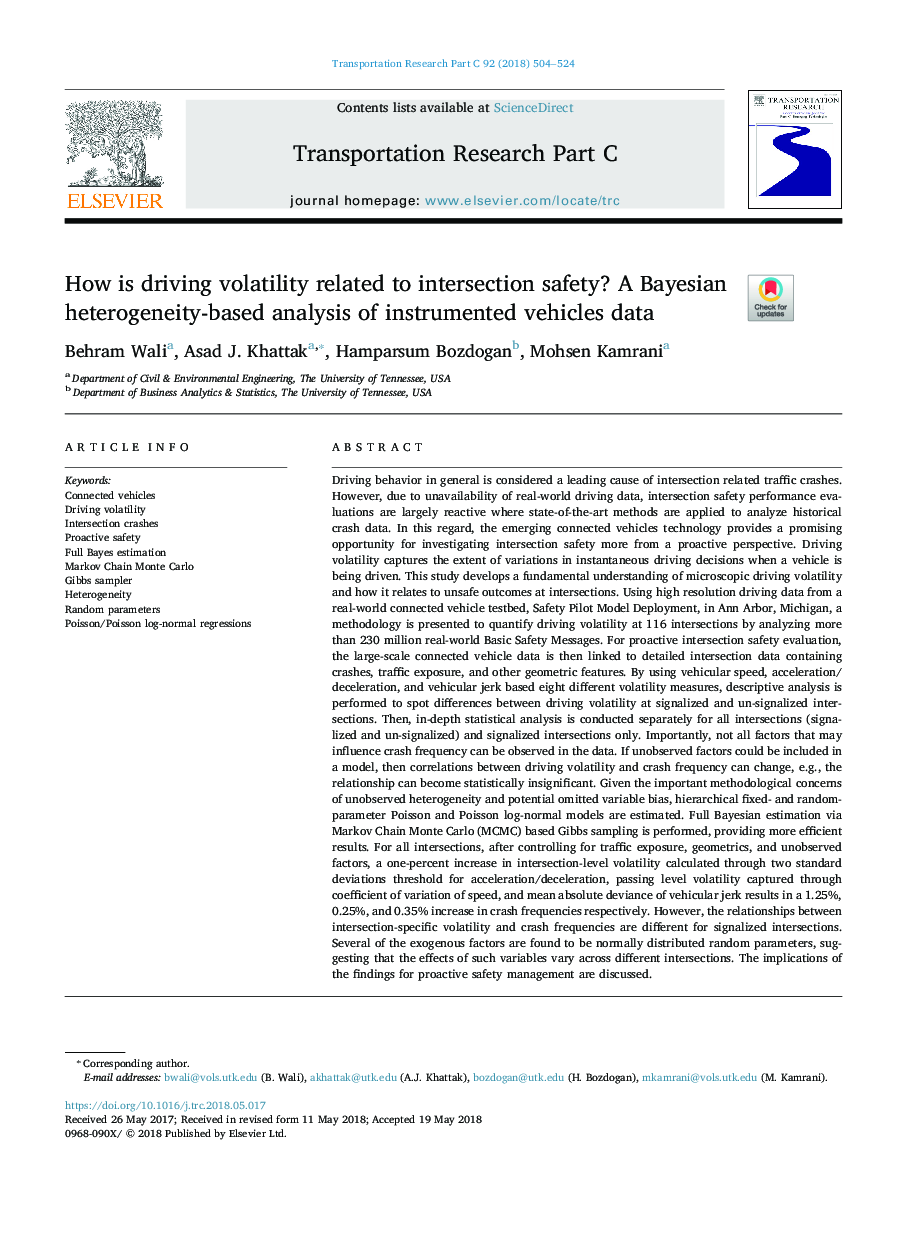| کد مقاله | کد نشریه | سال انتشار | مقاله انگلیسی | نسخه تمام متن |
|---|---|---|---|---|
| 6935884 | 1449656 | 2018 | 21 صفحه PDF | دانلود رایگان |
عنوان انگلیسی مقاله ISI
How is driving volatility related to intersection safety? A Bayesian heterogeneity-based analysis of instrumented vehicles data
ترجمه فارسی عنوان
چطور نوسانات رانندگی مربوط به ایمنی تقاطع است؟ تجزیه و تحلیل مبتنی بر ناهمگونی بیزی در مورد وسایل نقلیه ابزار
دانلود مقاله + سفارش ترجمه
دانلود مقاله ISI انگلیسی
رایگان برای ایرانیان
کلمات کلیدی
موضوعات مرتبط
مهندسی و علوم پایه
مهندسی کامپیوتر
نرم افزارهای علوم کامپیوتر
چکیده انگلیسی
Driving behavior in general is considered a leading cause of intersection related traffic crashes. However, due to unavailability of real-world driving data, intersection safety performance evaluations are largely reactive where state-of-the-art methods are applied to analyze historical crash data. In this regard, the emerging connected vehicles technology provides a promising opportunity for investigating intersection safety more from a proactive perspective. Driving volatility captures the extent of variations in instantaneous driving decisions when a vehicle is being driven. This study develops a fundamental understanding of microscopic driving volatility and how it relates to unsafe outcomes at intersections. Using high resolution driving data from a real-world connected vehicle testbed, Safety Pilot Model Deployment, in Ann Arbor, Michigan, a methodology is presented to quantify driving volatility at 116 intersections by analyzing more than 230 million real-world Basic Safety Messages. For proactive intersection safety evaluation, the large-scale connected vehicle data is then linked to detailed intersection data containing crashes, traffic exposure, and other geometric features. By using vehicular speed, acceleration/deceleration, and vehicular jerk based eight different volatility measures, descriptive analysis is performed to spot differences between driving volatility at signalized and un-signalized intersections. Then, in-depth statistical analysis is conducted separately for all intersections (signalized and un-signalized) and signalized intersections only. Importantly, not all factors that may influence crash frequency can be observed in the data. If unobserved factors could be included in a model, then correlations between driving volatility and crash frequency can change, e.g., the relationship can become statistically insignificant. Given the important methodological concerns of unobserved heterogeneity and potential omitted variable bias, hierarchical fixed- and random-parameter Poisson and Poisson log-normal models are estimated. Full Bayesian estimation via Markov Chain Monte Carlo (MCMC) based Gibbs sampling is performed, providing more efficient results. For all intersections, after controlling for traffic exposure, geometrics, and unobserved factors, a one-percent increase in intersection-level volatility calculated through two standard deviations threshold for acceleration/deceleration, passing level volatility captured through coefficient of variation of speed, and mean absolute deviance of vehicular jerk results in a 1.25%, 0.25%, and 0.35% increase in crash frequencies respectively. However, the relationships between intersection-specific volatility and crash frequencies are different for signalized intersections. Several of the exogenous factors are found to be normally distributed random parameters, suggesting that the effects of such variables vary across different intersections. The implications of the findings for proactive safety management are discussed.
ناشر
Database: Elsevier - ScienceDirect (ساینس دایرکت)
Journal: Transportation Research Part C: Emerging Technologies - Volume 92, July 2018, Pages 504-524
Journal: Transportation Research Part C: Emerging Technologies - Volume 92, July 2018, Pages 504-524
نویسندگان
Behram Wali, Asad J. Khattak, Hamparsum Bozdogan, Mohsen Kamrani,
